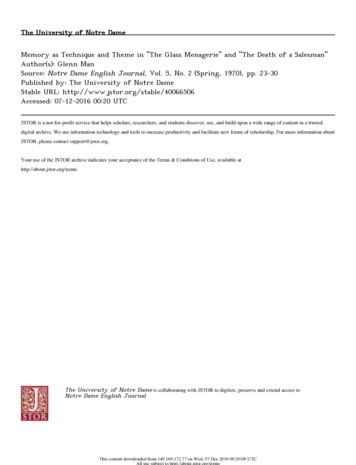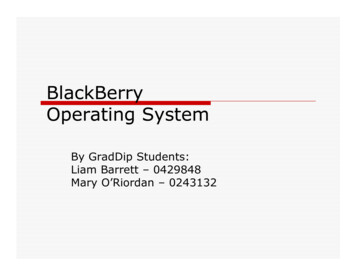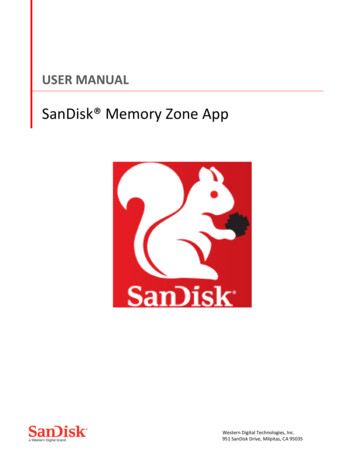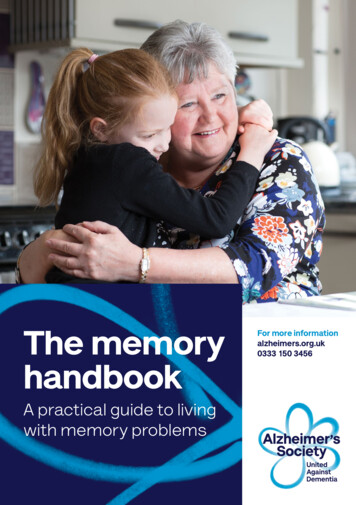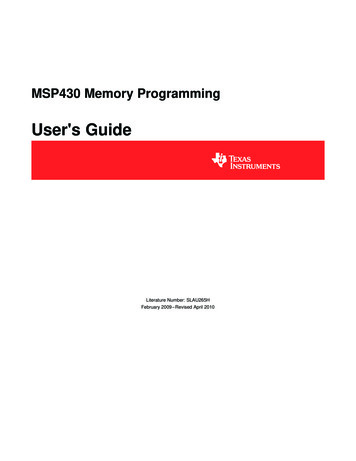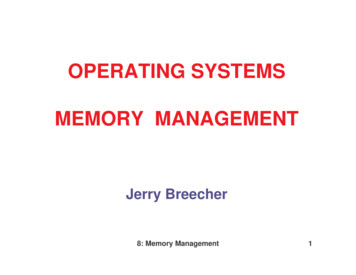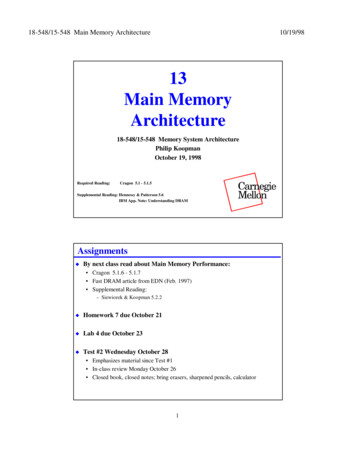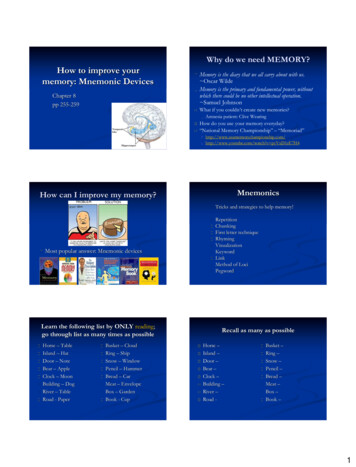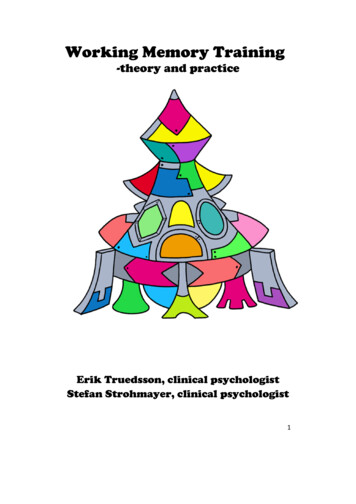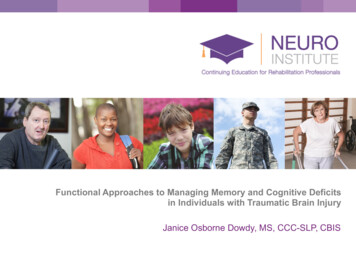
Transcription
Functional Approaches to Managing Memory and Cognitive Deficitsin Individuals with Traumatic Brain InjuryJanice Osborne Dowdy, MS, CCC-SLP, CBIS
Objectives In this course, participants will 1.Understand what is cognition2.Understand how deficits “look”3.Learn strategies to improve and compensate for deficits.
Incidence of TBI – CDC data 2015
Incidence of TBI}}}Falls are the most common cause for TBI inboth 0-14 age range, and again in 65 plusage range. Falls are the leading cause of TBIdeath in the 65 plus range.Blunt trauma is the second leading cause ofTBIIn all age ranges, motor vehicle accidentswere the 3rd leading cause of TBI. MVAs arethe leading cause of TBI death in 0-24 yearsof age range.
Incidence of TBI}}There are approximately 50 million people inthe United States living with TBI disabilitycurrently.Highest risk for TBI Being a male Age – young and old at highest risk, then 18-45age range (particularly males).
Problems after a TBIMotor} Cognitive} Communication} Psychosocial}
What is cognition?}}}}}}}Attention and concentrationProcessing and understanding informationMemoryCommunicationPlanning, organizing, and assemblingReasoning, judgement, problem-solving, anddecision making.Controlling impulses and emotions
What is cognition?}MEMORY Sensory Memory Short Term Memory (Working Memory) Long Term Memory Explicit and Implicit Declarative and Procedural Episodic and Semantic
What does it look like to haveproblems in these areas?
Attention and Concentration Problems}}}}Paying attention and focusing on a taskFinishing a project – from simple such astaking a shower to complex such ascompleting a task required for work.Sitting still, carrying on conversationTolerating being in the community in a noisyor hectic environment such as a restaurant ormall.
Problems Processing and Understanding Informationology}}}}}Taking a longer time to grasp what others aresayingTaking more time to understand and followdirectionsHave trouble following the plot of televisionshows or moviesTaking longer to read and understandinformation such as a newspaper or bookSlower to complete even routine tasks suchas getting dressed or cooking a meal.
Language and Communication Problems}}}}}}}Difficulty thinking of the correct wordTrouble starting, following, understandingconversationDifficulty staying on topicDifficulty expressing thoughts in anorganized mannerDifficulty communicating thoughts andfeelings using facial expressions and tone ofvoiceHaving trouble reading others thoughts andfeelingsMisunderstanding jokes and sarcasm – beingvery “black and white”
Problems Learning and Remembering New Information}}}Related to memory deficitsDifficulty with learning new routines andsystemsMay remember some parts of events orconversations, but may appear to confabulateparts to “fill in the gap”
Planning and Organization Problems}}}Difficulty planning schedules and followingthemTrouble with things requiring multiple stepsfrom simple to complex tasks.May lose or misplace items frequently, blameothers for moving items or taking from them.
Problems with Reasoning, Problem Solving, and Judgment}}}}Difficulty realizing there is even a problem tostart with .Rigid thinking – trouble analyzing optionsand solutions or changing the way they thinkQuick judgmentsActing without thinking about theconsequences
Inappropriate, Embarrassing, or Impulsive Behavior}}}}Denying cognitive problemsSaying hurtful or insensitive thingsCursing or acting “out of character” comparedto pre-injury selfLacking awareness of social boundaries Sexually inappropriate Invading personal space Oversharing information with “strangers”
Memory - http://www.human-memory.net/types.html
Memory after TBI}Most common deficit with memory Short Term Declarative Memory Prospective Memory
Process of Storing Memory}}AttentionEncoding Information Being able to “understand” the information}Storage Moving information to a specific area of the brain}Retrieval Searching the “files” and pulling out a memory
Process of Storing Memory}Memory failure can be attributed tobreakdown of one of these processes, whichis frequently occurs after any degree of TBI.
So can we “fix” any of theseproblems, and if so, how?
Remediation Vs. Compensation}Two approaches Fixing the problem – Remediation Coming up with ways to do the things you need todo, in a new way – Compensation}Most progress and increase in skills can beseen from combination of the 2 approaches.
Principles of Neuroplasticity}Neuroplasticity: The brain's ability toreorganize itself by forming new neuralconnections throughout life. Neuroplasticityallows the neurons (nerve cells) in the brainto compensate for injury and disease and toadjust their activities in response to newsituations or to changes in their environment.
Principles of Neuroplasticity}Use it or lose it}Use it and improve it}Specificity}Repetition Matters Not using functions of your brain can lead to nolonger being able to use them Training a specific brain function can lead to animprovement in that function The nature of the training dictates the nature of theplasticity Induction of plasticity requires sufficient repetition
Principles of Neuroplasticity}Intensity matters Induction of plasticity requires sufficient trainingintensity}Time matters Different forms of plasticity occur at different timesduring the training}Salience matters The training experience must be sufficiently salient toinduce plasticity}Age matters Training induced plasticity occurs more readily in youngbrains
Principles of Neuroplasticity}Transference Plasticity in response to ones training experiencecan enhance the acquisition of similar behaviors}Interference Plasticity in response to one experience caninterfere with the acquisition of other behaviors.
Treatment}}Metamemory, a type of metacognition, is boththe introspective knowledge of one's ownmemory capabilities (and strategies that can aidmemory) and the processes involved in memoryself-monitoring. This self-awareness of memoryhas important implications for how people learnand use memories.It was long thought that explicit memory wasrequired for metamemory, but in the 20 years ithas been seen that implicit memory plays quite arole in metamemory.
Treatment}}}Individualize the educational informationprovided about the client’s specific memoryand cognitive difficultiesInvolve the client in setting specific goals andselecting memory aidsCreate opportunities for accurate selfmonitoring Providing a delay between a prediction for amemory task, allows cueing for memory aid, thusgiving self-monitoring and self-control an explicitconnection
Treatment}Anosagnosia Lack of awareness into deficits}Anosagnosia is one of the biggest challengesin success with individuals with a TBI. Provide “safe” opportunities for failure Example would be allowing the person to make a meal“their way” and it not turn out – burnt toast, runnybrownies, yucky coffee Breakdown and discuss task failures immediatelyafter they occur – provide specific feedback.
Treatment}}}}}Drill and PracticeDual Task TrainingErrorless learningRole playingSituational coaching
Compensatory Training}Internal Memory Aids }Visual imageryCategory groupingMnemonicsRehearsal strategiesExternal Memory Aids Written planning systems (calendar, notebook,planner appointment book) Electronic planners (PDA, Blackberry, notepad oncellphone) Computer based planning (Outlook, Googlecalendar) that links between devices
Compensatory Training}External Memory Aids Items that can be task specific Lists to check off and complete ADLS – showering,doing laundry, grocery list Post It notes (can easily get overwhelming without a“system”) Pill organizer Key finder Dry erase board/bulletin board Television Assisted Prompting (TAP) NeuroPage systemFooter32
Compensatory Training}Establishing both internal and externalSUCCESSFUL memory aids requires them tobe individualized to the client and reevaluated as needed to modify and advancethe complexity Start at level of establishing orientation Advance to higher level tasks – cautious to establishsuccess at each level
General Recommendations for Individuals with TBI and Caregivers}}}}}}}Minimize distractions – work in a quiet roomFocus on one activity at a timeTake a break when you feel tiredAllow extra time to complete tasksRe-read and discuss new information , try toput it in “your own words”Try not to talk down to the person havingdifficulties, use a calm voice, and kind wordsDo not speak too fast or say too much atonce
General Recommendations for Individuals with TBI and Caregivers}}Put together a structured routine of dailytasks and activities – and follow it – as closeas possible, including sticking to plannedtimes to eat, practice for therapy, completebasic ADLs, wake up, and go to bed.Set specific locations for keeping things – aplace for medication box, a hook to keepkeys by door, table for purse/memory book/items you need to take to therapy or work,keep a notebook next to the telephone formessages/details of conversation
General Recommendations for Individuals with TBI and Caregivers}Schedule out the whole month – Examples: }}Grocery on TuesdayPay bills on 15th and 30thDry cleaners every other MondayTherapy M/W/FUse direct deposit and automatic bill pay foras many items as possibleUse apps such as GoodBudget to keep trackof expenses
General Recommendations for Individuals with TBI and Caregivers}Social Situations Think ahead about situations which might result inpoor judgment As a caregiver, give supportive and realisticfeedback when you observe the inappropriatebehavior Provide clear expectations before you get there Plan and rehears social interactions so they will bepredictable and consistent. Establish a verbal and non-verbal cueing system
Final Thoughts .}}}TBI is often a silent problem .you look “FINE”TBI does not just impact the person whosuffers it, but the entire family, social, andwork network of the survivor.Take it one day, one week, one month at atime .
Comments/Questions?Thank you for participating in Today’s NeuroInsitute WebinarYour Quiz & Evaluation will be sent to you within a couple hours
memory capabilities (and strategies that can aid memory) and the processes involved in memory self-monitoring. This self -awareness of memory has important implications for how people learn and use memories.} It was long thought that explicit memory was required for metamemory, but in the 20 years it has been

